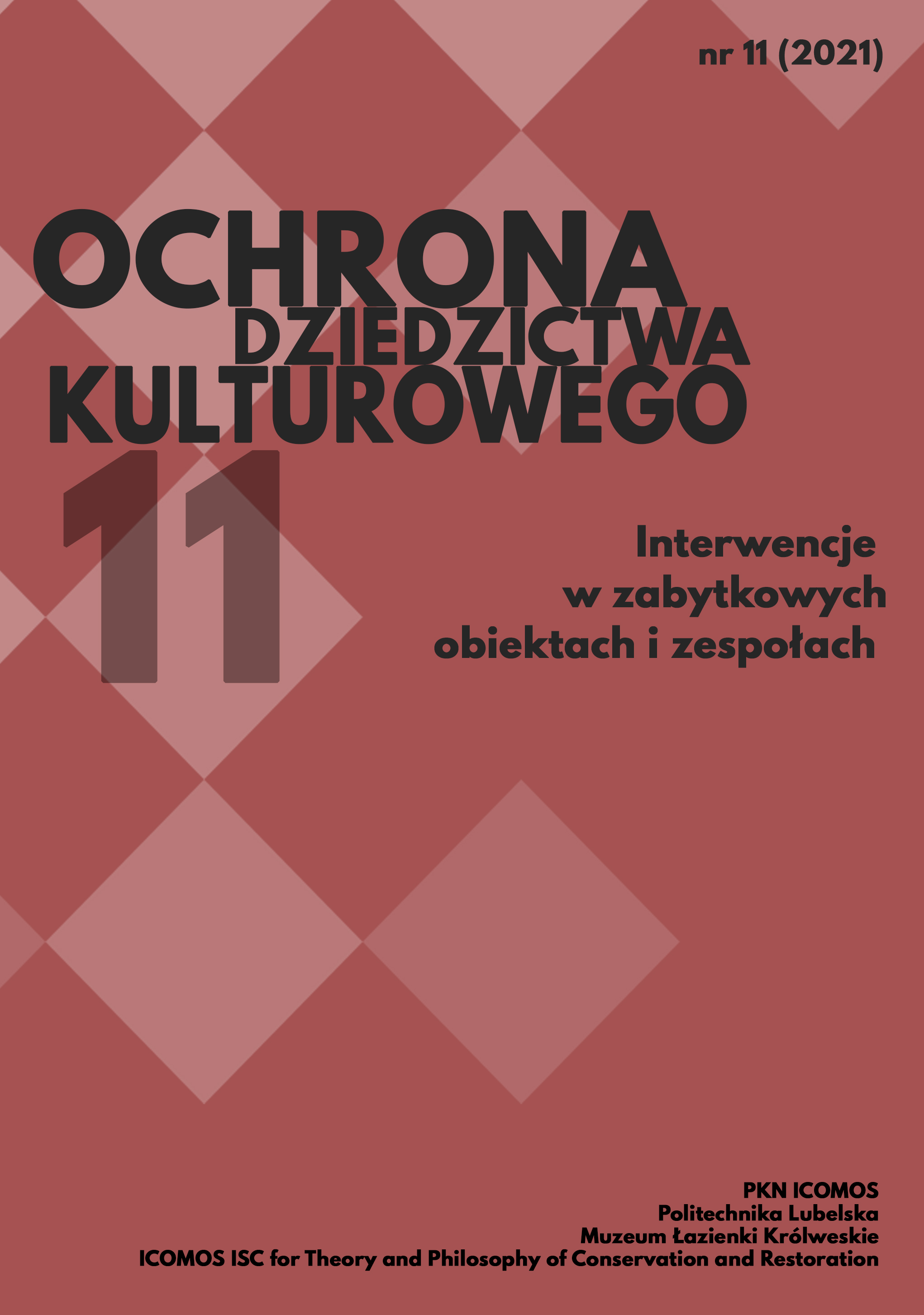Letting Go: the Limits of Intervention
Article Sidebar
Open full text
Issue No. 11 (2021)
-
Letting Go: the Limits of Intervention
Grzegorz Bukal1-12
-
Transformation of Historic Buildings – an Attempt at Codification
Piotr Molski13-26
-
Problems of Protection of Historical Industrial Buildings on the Example of the Port and Shipyard Complex in Gdynia
Robert Hirsch, Celina Łozowska27-42
-
New Old Town in Elbląg – Multi-faceted Intervention in a Historic Area
Katarzyna Wiśniewska43-64
-
Urban Conservation in International Charters: From the Athens Charter to the Historic Urban Landscape Recommendation
Antonino Frenda, Marco Valle65-74
-
Integrity versus Intervention Boundaries in Modernist Housing Complexes
Case study of the healt/holiday districts in UstrońBłażej Ciarkowski75-86 -
São Luiz do Paraitinga: The Image of São Paulo State in the 18th Century
Rogério Pereira de Campos, Maria Fernanda Rodrigues, Anibal Costa, Humberto Varum87-105
-
Tenement House "Pod Kruki", Market Square 25, Krakow. The Present of History – the Layering of the Future
Marcin Włodarczyk, Małgorzata Mariola Włodarczyk107-126
-
The Latest Strategic Documents Specifying Changes in the Approach to the Modernization of Monuments in Poland
Katarzyna Pałubska, Katarzyna Zalasińska127-142
-
Parks, Gardens and Other Forms of Composed Greenery – Boundary Conditions for Contemporary Interventions
Dorota Sikora143-160
-
Criteria to Be Met by Contemporary Design Works Transforming the Form and Utility Program of Historic Sacred Architecture in the View of Selected Examples from Europe
Konrad Szumiński161-170
-
Analysis of the Component Values of the Historic Urban Complex – the Basis for Conservation Programs and Plans
Boguslaw Szmygin171-179
-
ICOMOS Heritage Impact Assessment – Application to National Conservation Practice
Marcin Górski181-199
Main Article Content
DOI
Authors
Abstract
The purpose of this paper is to draw attention to the issue of the final limit of conservation interventions towards architectural monuments in the context of a holistic concept of heritage protection. The full text is addressed to Polish readers due to its special reference to the situation in the Polish system of protection of architectural heritage.
Although architecture belongs to the sphere of applied arts, most of the buildings were not created as works of art. Their raison d'être was - and still is - the possibility of implementing technical tasks in a manner strictly meeting the users' expectations. They were mostly subordinated to the principles of technology and economy. Their life cycle assumed even aesthetically degrading transformations, wear and tear as well as planned or unplanned end. The end of existence of an ordinary building is as natural as the pursuit of an eternal preservation of a (traditionally understood) work of art in its original condition. And such an end should be perceived as natural, and in some circumstances acceptable, even from conservation point of view. By adopting the concept of overwhelming “heritage” uncritically, Polish law allows it possible to extend protection to every building from undefined “past era”, regardless of its condition, without a question of the technical feasibility of the intervention. In the absence of an objective assessment system, this led to a huge increase in the number of buildings entered in the list of monuments and to the ineffectiveness of the formal protection. It has also worsened the ability to protect still existing and very neglected objects of real monumental values.
Keywords:
References
Bukal G., Produkcja zabytków jako problem konserwatorski (przykład Gdańska) [w:] Współczesne problemy teorii konserwatorskiej w Polsce, red. B. Szmygin, PKN ICOMOS, Warszawa 2008, s. 17-24;
Bukal G., Ochrona i zagrożenie wartości zabytków – czyli o skutkach braku wartościowania i co dalej… [w:] Wartościowanie zabytków architektury red. B. Szmygin, PKN ICOMOS, Warszawa 2013, s. 61-70.
Convention Concerning the Protection of the World Cultural and Natural Heritage, https://whc.unesco.org/en/conventiontext.
Decyzja Pomorskiego Wojewódzkiego Konserwatora Zabytków w sprawie wpisania do rejestru zabytków z dn. 07.01.2020, PWKZ. 5140.5.2017. (AK) PŚ, s. 10.
https://www.nid.pl/pl/Informacje_ogolne/Zabytki_w_Polsce/Ewidencja_zabytkow.
Orchowska-Smolińska A., Woźniakowski A., Ekspertyza określająca dopuszczalny zakres ingerencji inwestycyjnej na terenie zespołu zabytkowego dawnej Stoczni Gdańskiej w Gdańsku w kontekście zachowania krajobrazu kulturowego oraz ochrony wartości dziedzictwa materialnego i niematerialnego tego obszaru, miejsca proponowanego do wpisu na Listę Światowego Dziedzictwa. Gdańsk 2019.
Przyłęcki M., Ekspertyza zabytkowego pałacu w Głębowicach w woj. wrocławskim. Wrocław, 1996.
Raport o stanie zachowania zabytków nieruchomych w Polsce. Zabytki wpisane do rejestru zabytków (księgi rejestru A i C). Narodowy Instytut Dziedzictwa, Warszawa 2017.
Ustawa z dnia 23 lipca 2003 r. o ochronie zabytków i opiece nad zabytkami Dz. U. z 2021 r. poz. 710, 954, Art. 6. 1.
Zybała T., Analysis of the state of preservation the historic arcaded houses in Vistula Delta listed in the National Inventory of Historical Monuments, Budownictwo i Architektura, 2021, w druku. DOI: https://doi.org/10.35784/bud-arch.2345
Article Details
Abstract views: 268
License

This work is licensed under a Creative Commons Attribution-ShareAlike 4.0 International License.






